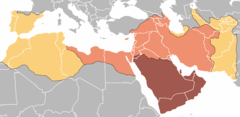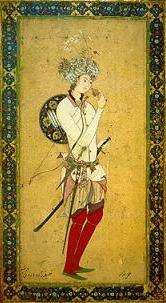List of Muslim states and dynasties
(This article lists some of the states, empires, or dynasties that were ruled by a Muslim elite, or which were in some way central to or a part of a Muslim empire.)
All the disparate Islamic Empires can all be traced back to Muhammad, as the founder not only of the Islamic faith but also the first leader of the Muslim people.
Scholars debate what exactly constitutes an empire. One definition defines an empire as a state that extends dominion over areas and populations culturally and ethnically distinct from the culture/ethnicity at the center of power.
History of Muslim states
The early Muslim conquests began in the lifetime of Muhammad. His successors conquered large swaths of the Middle East and North Africa, in addition to parts of parts of southern Europe and the Indian subcontinent, in the decades after his death. The caliphate founded by his earliest successors, called the Rashidun caliphate, was succeeded by the Umayyad caliphate and later the Abbasid caliphate.
While the caliphates gradually fractured and fell, other Muslim dynasties rose; some of these dynasties grew into "Islamic empires", with some of the most notable being the Safavid, Ottoman, and Mughal Empires.
Caliphates

- The Rashidun Caliphate (632–661) – Beginning of the Islamic Empire
- The Umayyad Caliphate (661–750) – Successor of the Rashidun Caliphate
- The Umayyad Caliphate of Cordoba in Islamic Spain (929–1031)
- The Abbasid Caliphate (750–1258) – Successor of the Umayyad Caliphate, Fall of Baghdad (1258)
- The Fatimid Caliphate (909–1171) End of the Arab Empire
- The Almohad Caliphate (1121–1269)
- The Ottoman Caliphate (1362–1924)
- The Sokoto Caliphate (1804-1903)
- The Sharifian Caliphate (1924-1925)
Regional empires
.jpg)
Grouped by capital or core region
Iran
- The Persian Empire, under the Safavid dynasty (1502–1736), Afsharid dynasty, and Qajar dynasty
- The Ilkhanate (Mongol)
- The Khwarezmian Empire - The Khwarezm-Shâh Dynasty
- The Buyid dynasty
- The Shirvanshah
- The Great Seljuq Empire
- The Saffarid dynasty
- The Ak Koyunlu
- The Kara Koyunlu
- The Muzaffarids
- The Tahirid dynasty
- The Ghurids
- The Ghaznavid Empire
Middle East
- The Tulunids (868-905, Egypt and Syria)
- The Ayyubid Dynasty
- The Mamluk Dynasty
- The Sharifate of Mecca
- The Qarmatian empire
- The Rassids of Yemen
- The Rasulid of Yemen
- The Kingdom of Saudi Arabia
- The Sultanate of Oman
Anatolia (Turkey)
- The Ottoman Empire (1299–1923)
- The Seljuk Sultanate of Rûm (1077–1308)
- The Danishmends Dynasty (1071–1178)
- The Mengujekids Dynasty (1072–1277)
- The Saltukids Dynasty (1071–1202)
- The Artuqids Dynasty (1101–1409)
Sub-Saharan Africa
- The Mali Empire (1230s–1600s)
- The Songhai Empire (1340–1591)
- The Adal Sultanate (1415–1555)
- The Ajuran Empire (13th century–17th-century)
- The Kanem empire
- The Fulani Empire of Sokoto
- The Fulani or Fulbe Empire of Macina of Seku Amadu
- The Fulani or Fulbe Empire of El Hajj Oumar Tall
- The Fulani or Fulbe Empire of Boundou of Malick Daouda Sy
- The Kilwa Sultanate (10th century–1517)
North Africa
- The Almoravid dynasty (1040–1147) of Morocco
- The Almohad dynasty (1121–1269) of Morocco
- The Aghlabid dynasty of Ifriqiya Tunisia, East-Algeria, West-Libya and Sicily
- The Hafsid dynasty (1229–1574)
- The Alaouite dynasty of Morocco
- The Marinid dynasty of Morocco
- The Rustamid dynasty
- The Wattasid dynasty of Morocco
- The Saadi dynasty of Morocco (1511–1628)
- The Dervish State (1896–1920)
Europe
Southern Europe
- Caliphate of Cordoba (Al-Andalus) (929–1031)
- The Emirate of Bari (847–871)
- The Emirate of Sicily (965–1072)
Eastern Europe
- The Volga Bulgaria (922–1236)
- The Golden Horde (1251–1502)
- The Kazan Khanate (1438–1552)
- The Astrakhan Khanate (1466–1556)
- The Qasim Khanate (1452–1681)
- The Crimean Khanate (1441–1783)
- The Bashkirs
Central Asia
- The Karakhanid empire: 840-1212, in Transoxiana
- The Khwarazmian empire
- The Timurid dynasty
- The Chagatai Khanate
- The Siberia Khanate
- The State of Yarkand
- The Shaybanids
- The Samanid dynasty
South Asia
- India (including Afghanistan, Pakistan and Bangladesh)
- The Mughal Empire in India (1526–1857), styled Badhsah-i Hind
- The Sur Empire founded by the Afghan in North India and South Asia with the government styled Sultanate (1540-1556)
- The Mamluk dynasty of Delhi (1206–1290)
- The Khilji Dynasty (1290–1320)
- The Tughlaq dynasty (1321–1398)
- The Bahmani Sultanate (1347-1527)
- The Bengal Sultanate (1352-1576)
- The Jaunpur Sultanate (1394-1479)
- The Gujarat Sultanate (1407-1573)
- The Malwa Sultanate (1392-1562)
- The Deccan Sultanates (1527-1686)
- The Sultanate of Maldives
Southeast Asia
Malay Archipelago (East Indies) (Indonesia,Malaysia and Brunei)
- The Malacca Empire
- The Bruneian Empire
- The Sultanate of Aceh
- The Sultanate of Johor
- The Sultanate of Kedah
- The Sultanate of Kelantan
- The Sultanate of Perak
- The Sultanate of Pahang
- The Sultanate of Selangor
- The Terengganu Sultanate
- The Borneo Sultanate
- The Kingdom Demak
- The Yogyakarta Sultanate
- The Perlis Kingdom
- Philippines Islands
- The Sultanate of Maguindanao (also call Mindanao)
- The Sultanate of Sulu
See also
References


